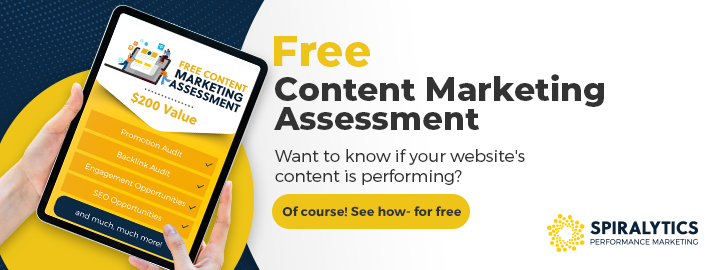In the past few months, we’ve been experimenting and building various linkable content to improve our site’s backlink profile. During one of our brainstorming sessions, we stumbled upon these questions:
-
What do content pieces with over 200 links have in common with each other?
-
What makes these materials highly linkable?
While there are numerous blogs and videos about how to create linkable content, there is no existing data on the commonalities of the top performing content across different industries. We decided to answer the questions ourselves by conducting a study.
The Study Parameters
We scoured the web and selected 55 content pieces published by different businesses across various industries that’s known to heavily use content marketing strategies. For a material to qualify for the study, we made sure that it was published within the last five years (2013-2018) and it has over 200 referring domains.
It’s important to note that although the digital landscape is already saturated with blog posts, videos, infographics, and whitepapers, it was difficult to find content with over 200 links. But to ensure fairness and accuracy of results, we chose five content pieces for every industry that’s known to employ great content marketing.
The industries included in the study are:
- HR and Recruitment
- Marketing
- Food and Beverage
- Beauty and Fashion
- Electronics and Technology
- Personal Finance
- Art and Design
- Real Estate
- Education
- Transportation and Travel
- Health and Fitness
Because we wanted to focus on content that content marketers commonly produce, we excluded:
-
Pieces from news organizations and top magazine sites like Business Insider, Inc. etc.
-
Non-content pages (service pages, product pages, home pages)
-
Landing pages
-
Social media content including YouTube videos
From there, we extracted various data such as the number of Referring Domains, Domain Rating, Content Type, Word Count, Publishing Date, Ranking, Social Shares, Sentiment, Topics, and common words in the title. We checked for patterns and drilled down the details.
The Results
1. The listicle remains the champion
Out of the eight categories of content for links, the listicle ranked first as the most common, at 25.5%. This is not very surprising since it’s one of the most commonly produced type of content today.
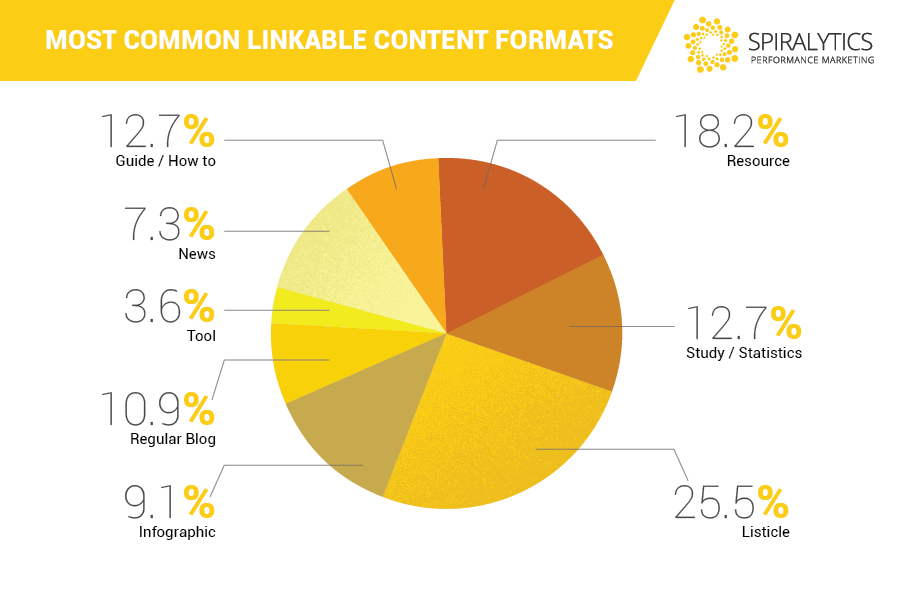
In recent years, listicles have been synonymous to lazy content marketing due to the overuse of the format. But, it’s important to note that 64% of the highly linkable listicles have more than 2,000 words.
In fact, 79% of the most linkable listicles are those that cover everything about the topic or that no one else can beat due to its length or extensiveness, just like The Simple Dollar’s How to Save Money: 100 Great Tips to Get You Started.
If you’re looking to produce a linkable listicle, find out if there are topics within your industry that are not yet covered by other sites. Make it the most comprehensive one possible so it would be difficult for your competitors to replicate.
2. Word count still matters
Digital Marketing guru, Neil Patel, promotes long form content for numerous reasons including social shares, organic traffic, and links. In his article, Why 3000+ Word Blog Posts Get More Traffic (A Data Driven Answer), he explained that producing evergreen, long-form content are more beneficial for companies since it helps in making them stand out against competitors that only produce articles around 500 to 1,000 words. Long form content is also guaranteed to attract more organic traffic and backlinks due to their perceived credibility.
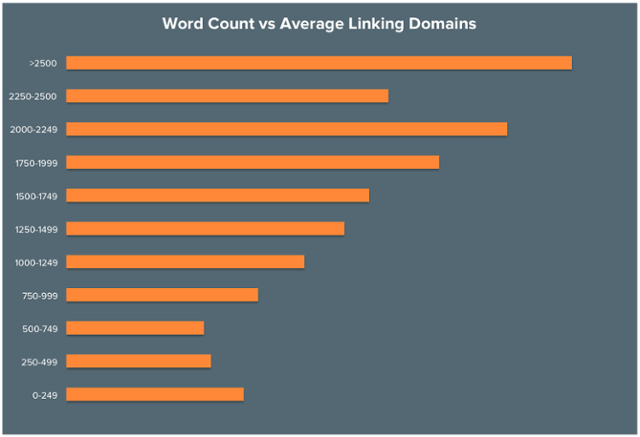
In 2012, Hubspot conducted a study about the most shareable, linkable, and popular posts using their own blog posts. They found out that their articles with more than 2,500 words are the most linkable.
Similarly, our study showed that content with more than 2,000 words gained the most referring links across multiple industries. Going further, 10% of the top linked content have more than 5,000 words, one of which even reached 40,000 words.
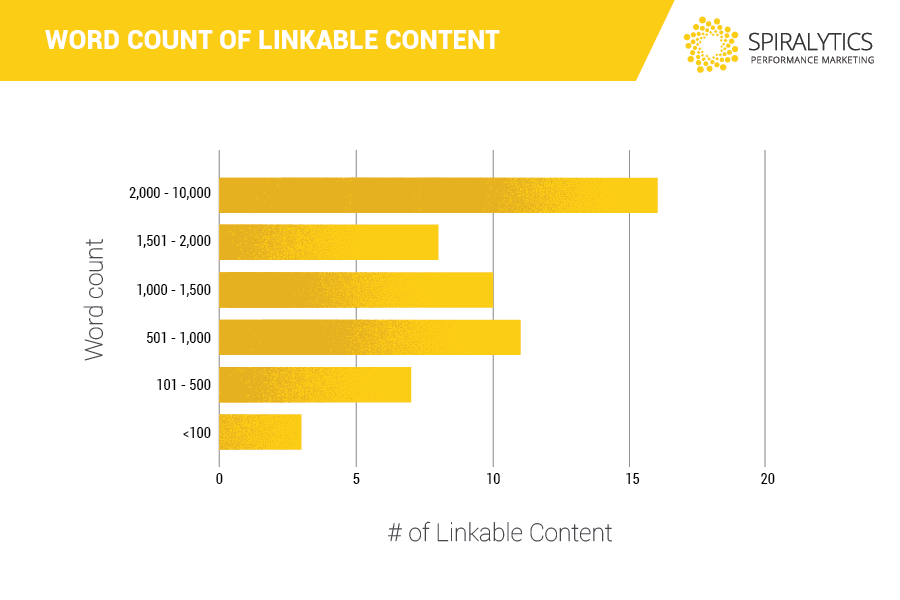
Surprisingly, content with 501 to 1,000 words, apart from being the second most linkable word count range, also had the highest average number of links per content. This is because all of these are either industry news, breakdown and opinion pieces of an industry news, or has a supplementary infographic and/or video.
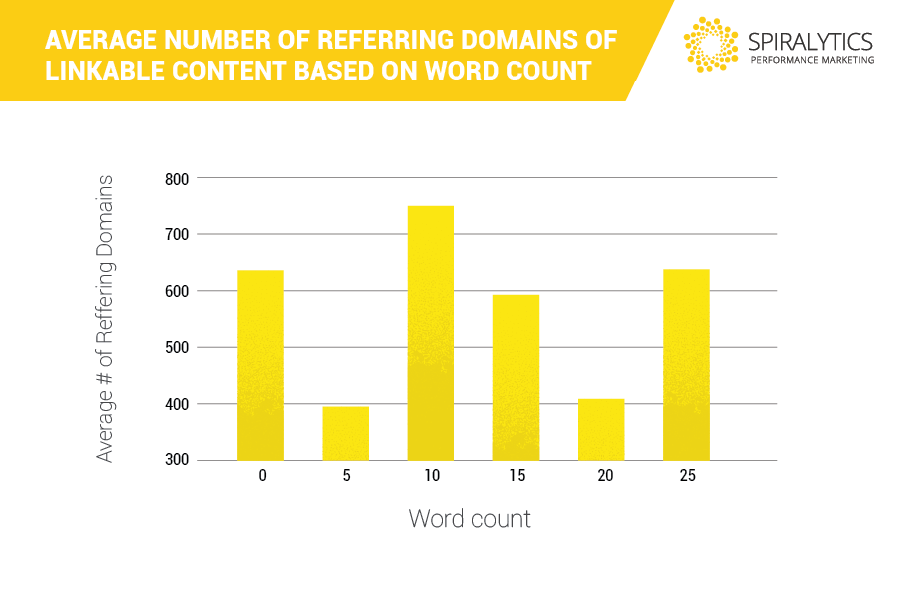
If we’re going to take a look at the table above, you’ll see that content with less than 100 words still performed well in terms of average number of referring domains. Note that all of these content pieces are tools or calculators – content that do not require a lot of words, but still require a lot of time to produce.
This further supports the findings of Orbit Media about the correlation between the effort you put into a content with its performance — in this case, linkability.
3. Negative titles get the clicks but not the links
A 2014 study by Outbrain showed that blogs with negative headlines performed better in terms of clicks and pageviews. However, if your goal is to get links, it would be better to stick with a neutral tone.
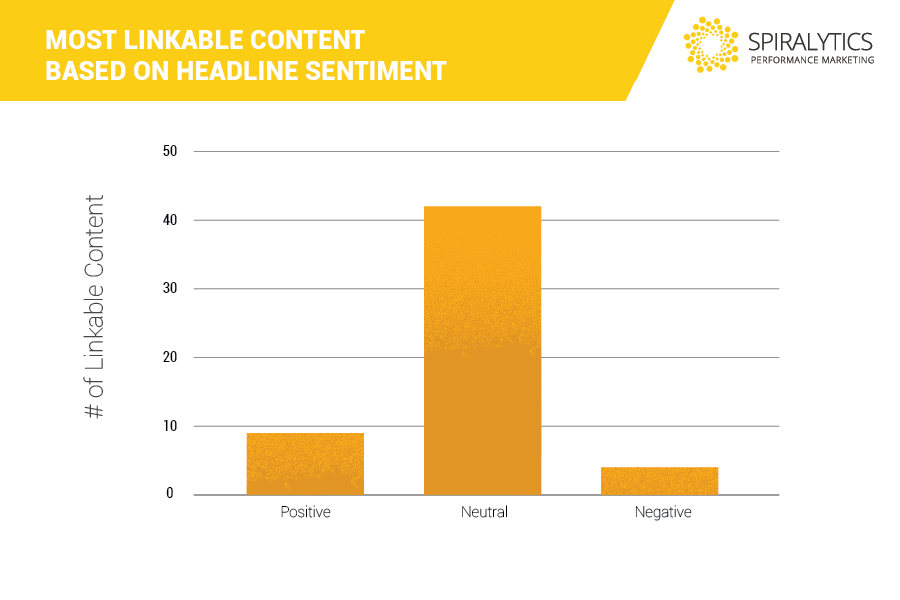
The graph above shows a stronger correlation between neutral titles and linkability over the ones with negative and positive headlines. For a content to be considered link worthy by other content creators, it should discuss both the positive and negative aspects of the topic to be considered a credible and unbiased reference.
4. Visuals elevate content linkability
Although infographics only came in 6th in the ranking of the most linkable content formats, visuals, in general, help improve the linkability of your content.
In fact, our study showed that 23% of linkable content contain infographics and/or charts, and 16% has accompanying videos.
Images not only help in telling the story, but also in reducing friction since repurposing images is the easiest way for other content creators to share your content. So, if there’s an opportunity to visualize some sections of your linkable content, don’t hesitate to do so.
5. Keeping your content evergreen helps you stay on top
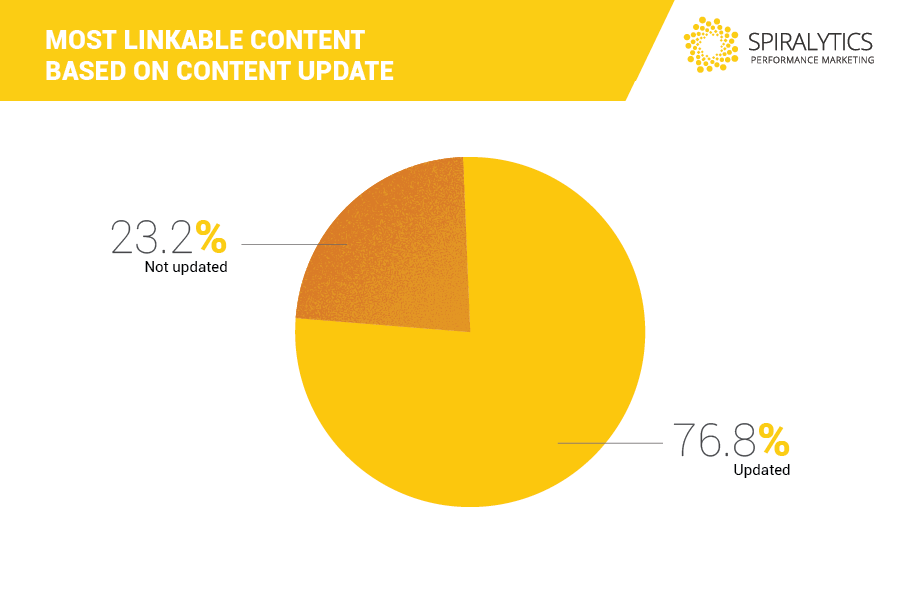
It’s no surprise that 76% of the most linkable content on the web have been updated at least once. Keeping the content evergreen ensured that they have the best possible version of the topic, making it difficult for their competitors beat their ranking.
In the same study by Orbit Media, only 38% of content marketers surveyed said that they update their old content but those who do reported positive results.
It’s also interesting to note that even though 14.5% of the most linkable content have years on their titles, the years are only present on the title tags and not on the url, so they can be updated yearly.
6. Link building takes time and patience
In our study, 58% of the most linkable content have been published from 2014-2016. So, if you’re wondering how long it takes to get more than 200 Referring Domains, it’s safe to say that it’s around 2 to 4 years.
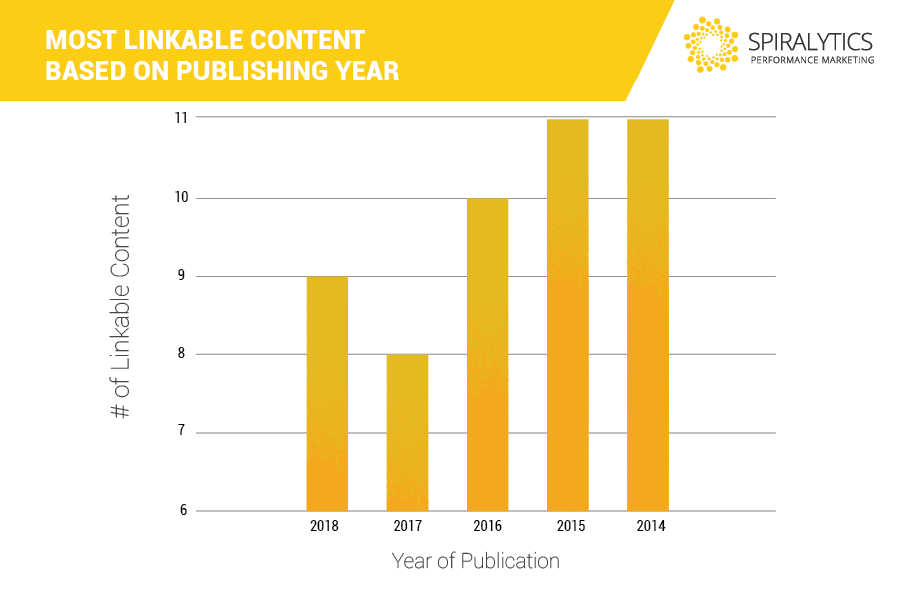 However, it’s possible to get a lot of links in one year, if other factors such as Domain Authority, Ranking, and budget for promotions are in your favor, as demonstrated by 16% of the most linked content that earned 200 or more referring domains on 2018.
However, it’s possible to get a lot of links in one year, if other factors such as Domain Authority, Ranking, and budget for promotions are in your favor, as demonstrated by 16% of the most linked content that earned 200 or more referring domains on 2018.
7. Top sites rake in the links
All websites can create linkable content, but it’s no secret that it’s easier for older and more popular websites to rank their new linkable content on the first page even if they don’t have a lot of links to it, all because of their high domain authority. Ranking on page one also helps them gain a lot of natural links for their content, which strengthens their backlink profile and authority even further.
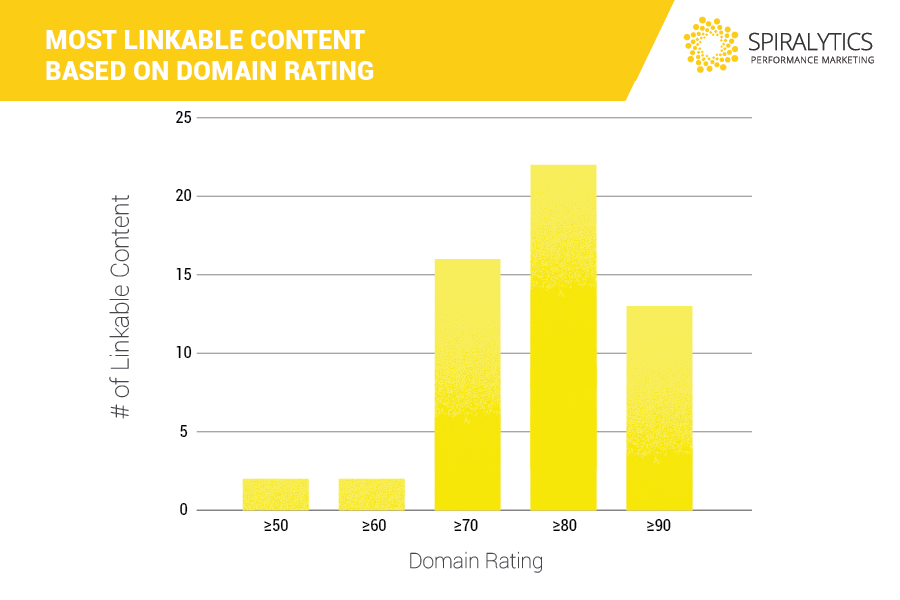
In fact, 93% of the most linkable content belong to sites with a Domain Rating of 70 or higher while the remaining 7% are between DR 50-69. Note that during our research process, we were unable to find content with 200+ links from sites with a DR of less than 50. This may mean that there are no or very few sites below DR 50 that can get more than 200 links.
93% of the most linkable content belong to sites with a Domain Rating of 70 or higher
In relation to that, 64% of the most linkable content are ranking on the first page for their primary target keyword. This can mean two things: the site’s authority propelled the content to the first page or their consistent production of quality content helped them reach their current DR. Either way, it’s undeniable that producing quality content has a strong correlation with a site’s authority. Additionally, ranking on the first page helps in generating natural links.
8. Tech brings in the interest
Though the content included in this study spans from 11 different industries, 27% of these were about or somehow related to technology and innovation. This supports one of the most common tips of content marketers – discussing trending topics in your industry.
Today, a lot of marketers want to be the first to report or discuss new tech advancements that could affect their entire industry because it establishes subject matter authority and helps in building links.
Expect to see these types of articles more as we approach the Fourth Industrial Revolution with new developments in Artificial Intelligence, machine learning, and other innovations, which can be applied to virtually all industries. If you don’t see any of your competitors doing this yet, it’s a great opportunity you should not miss.
9. Data will always be linkable
16% of the most linkable content are primarily anchored on data, whether it’s an independent study like Harvard Business Review’s The Most Desirable Employee Benefits or a collection of data from other sources, like the infographic Top 10 e-Learning Statistics for 2014 You Need To Know.
We also found a correlation between numbers in the title and linkability of the content. Our research showed that 36% of the most linkable content have numbers in the title,while 7% have the word statistics.
Content creators trust data and numbers when they’re looking for content to use as references. Kerry Jones from Moz further explained in her article that data-backed articles, specifically original research, earn a lot of natural links over time due to syndication of other sites that can potentially see your data from third-party websites you reached out to.
If you’re looking for data-backed, linkable content ideas, explore research or studies that you can conduct from your readily available data, such as customer surveys or product purchases.
Key Takeaway
Through the years, SEO practitioners have experimented with ways to understand and catch up with Google’s algorithm changes. One of those efforts is building links instead of just earning them naturally.
Surprisingly (or unsurprisingly), Google still maintained the quality and quantity of links as one of the primary ranking factors. This is because backlinks remain to be one of the strongest indicators of how a site values the experience of the audience. After all, reputable sites will only link back to well-researched and well-crafted content, even if you reach out to them and blatantly ask for the backlink.
When you’ve only been practicing SEO or content marketing for awhile, it’s so easy to get caught up on getting quick wins like reaching thousands of pageviews or shares. But if you’ve been in the field for a longer time, you know that there are bigger rewards in playing the long game a.k.a. consistently building content that will establish your authority and will solve the problems of your audience.
By creating content based on research, spending hours to make it the most extensive one yet, designing it to be easily understood by your audience, relentlessly promoting it on various channels, and updating it regularly, you’re setting up your site for more valuable rewards including earning links and ranking on the most-coveted spot of page one.
